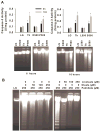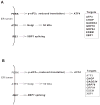The role of fatty acids in the development and progression of nonalcoholic fatty liver disease
- PMID: 18430557
- PMCID: PMC2551556
- DOI: 10.1016/j.jnutbio.2007.10.001
The role of fatty acids in the development and progression of nonalcoholic fatty liver disease
Abstract
Nonalcoholic fatty liver disease (NAFLD) has emerged as a serious obesity-related disorder. NAFLD encompasses a wide spectrum of hepatic derangements ranging from a surfeit of fat in the liver (steatosis) to lipid surplus accompanied by fibrosis and cellular death (nonalcoholic steatohepatitis or NASH). The most widely accepted model to explain the progression from simple NAFLD to NASH is the "two-hit hypothesis," wherein fat over accumulation per se is not sufficient to induce the progression to statohepatitis, but renders the liver more susceptible to "second hits" that, once imposed upon the steatotic liver, cause further aberrations that culminate in the development of NASH. However, in light of recent data from our laboratory and elsewhere, we propose that an increased ratio of saturated-to-unsaturated fatty acids delivered to or stored within the liver may, in part, mediate the progression from simple steatosis to NASH. The molecular mechanisms that mediate the effect of saturated fatty acids are unclear, although proinflammatory cytokines, reactive oxygen species, and endoplasmic reticulum stress may all play a role. Collectively, these data suggest that saturated fatty acids may represent an intrinsic second hit to the liver that hastens the development of NASH.
Figures




References
-
- Mokdad AH, Bowman BA, Ford ES, Vinicor F, Marks JS, Koplan JP. The continuing epidemics of obesity and diabetes in the United States. JAMA. 2001;286:1195–1200. - PubMed
-
- Mokdad AH, Ford ES, Bowman BA, Dietz WH, Vinicor F, Bales VS, Marks JS. Prevalence of obesity, diabetes, and obesity-related health risk factors. JAMA. 2003;289:76–79. - PubMed
-
- Must A, Spadano J, Coakley EH, Field AE, Colditz G, Dietz WH. The disease burden associated with overweight and obesity. JAMA. 1999;282:1523–1529. - PubMed
-
- Festi D, Colecchia A, Sacco T, Bondi M, Roda E, Marchesini G. Hepatic steatosis in obese patients: clinical aspects and prognostic significance. Obesity Reviews. 2004;5:27–42. - PubMed
-
- Clark JM, Diehl A. Nonalcoholic fatty liver disease: an underrecognized cause of cryptogenic cirrhosis. JAMA. 2003;289:3000–3004. - PubMed
Publication types
MeSH terms
Substances
Grants and funding
LinkOut - more resources
Full Text Sources

